Development Economics: Niger's Development and Comparative Analysis
VerifiedAdded on 2023/01/13
|18
|6588
|97
Report
AI Summary
This report provides a comprehensive analysis of Niger's development economics, exploring various facets of its economic landscape. It begins with an overview of Niger, discussing the challenges and trade-offs donor countries face when allocating funds to developing nations. The report then delves into two key economic theories, Mercantilism and Keynesian economics, evaluating their relevance to Niger's context. It further identifies indicators to assess a country's development status, focusing on Niger's progress relative to a developed nation like South Africa. The report also examines the outcomes of international summits involving Niger and assesses gaps in implementation. It concludes by proposing solutions and actions to foster Niger's development, including resource requirements. The report highlights key issues such as poverty, water scarcity, and the role of foreign aid in supporting Niger's economic growth.
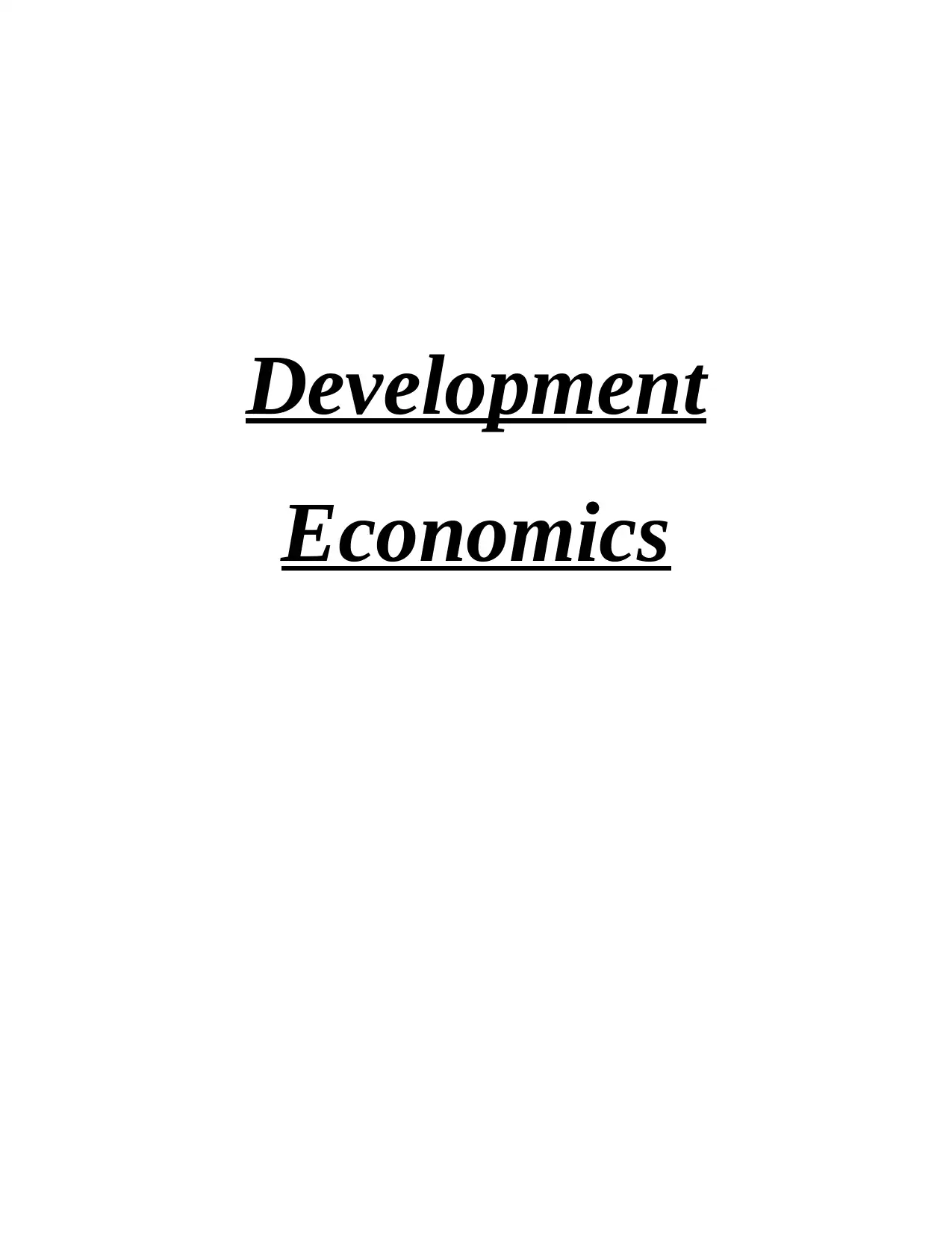
Development
Economics
Economics
Paraphrase This Document
Need a fresh take? Get an instant paraphrase of this document with our AI Paraphraser
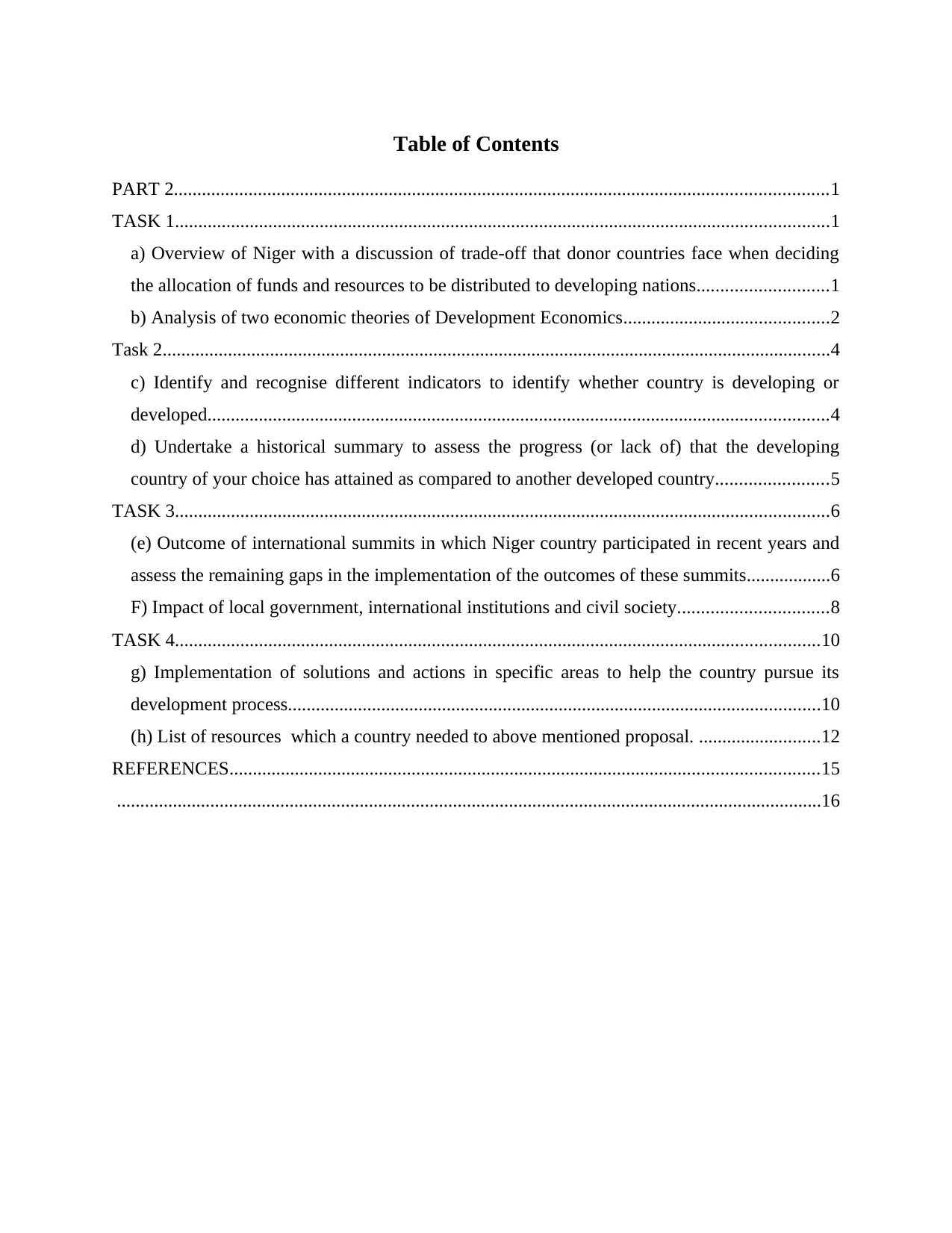
Table of Contents
PART 2............................................................................................................................................1
TASK 1............................................................................................................................................1
a) Overview of Niger with a discussion of trade-off that donor countries face when deciding
the allocation of funds and resources to be distributed to developing nations............................1
b) Analysis of two economic theories of Development Economics............................................2
Task 2...............................................................................................................................................4
c) Identify and recognise different indicators to identify whether country is developing or
developed.....................................................................................................................................4
d) Undertake a historical summary to assess the progress (or lack of) that the developing
country of your choice has attained as compared to another developed country........................5
TASK 3............................................................................................................................................6
(e) Outcome of international summits in which Niger country participated in recent years and
assess the remaining gaps in the implementation of the outcomes of these summits..................6
F) Impact of local government, international institutions and civil society................................8
TASK 4..........................................................................................................................................10
g) Implementation of solutions and actions in specific areas to help the country pursue its
development process..................................................................................................................10
(h) List of resources which a country needed to above mentioned proposal. ..........................12
REFERENCES..............................................................................................................................15
.......................................................................................................................................................16
PART 2............................................................................................................................................1
TASK 1............................................................................................................................................1
a) Overview of Niger with a discussion of trade-off that donor countries face when deciding
the allocation of funds and resources to be distributed to developing nations............................1
b) Analysis of two economic theories of Development Economics............................................2
Task 2...............................................................................................................................................4
c) Identify and recognise different indicators to identify whether country is developing or
developed.....................................................................................................................................4
d) Undertake a historical summary to assess the progress (or lack of) that the developing
country of your choice has attained as compared to another developed country........................5
TASK 3............................................................................................................................................6
(e) Outcome of international summits in which Niger country participated in recent years and
assess the remaining gaps in the implementation of the outcomes of these summits..................6
F) Impact of local government, international institutions and civil society................................8
TASK 4..........................................................................................................................................10
g) Implementation of solutions and actions in specific areas to help the country pursue its
development process..................................................................................................................10
(h) List of resources which a country needed to above mentioned proposal. ..........................12
REFERENCES..............................................................................................................................15
.......................................................................................................................................................16
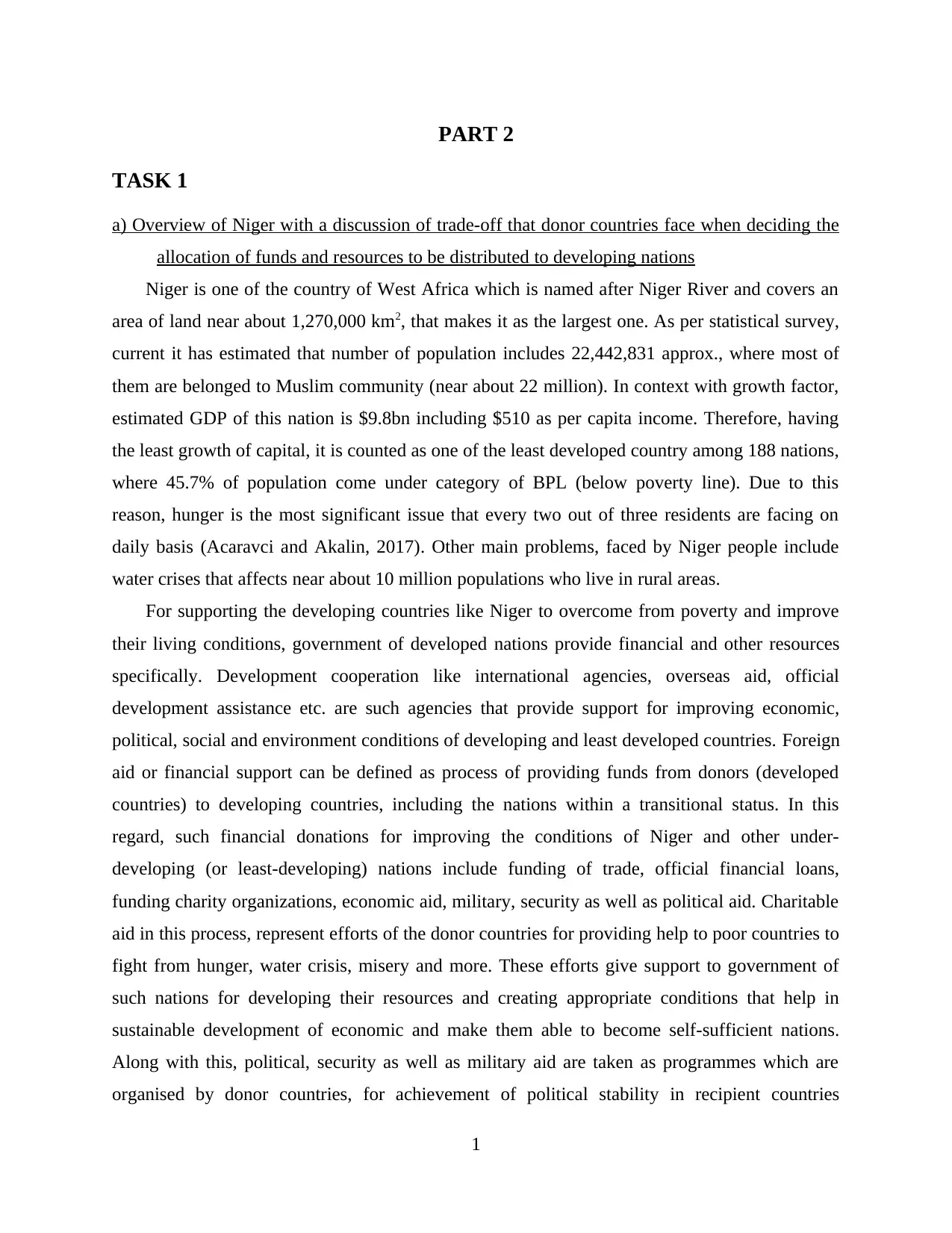
PART 2
TASK 1
a) Overview of Niger with a discussion of trade-off that donor countries face when deciding the
allocation of funds and resources to be distributed to developing nations
Niger is one of the country of West Africa which is named after Niger River and covers an
area of land near about 1,270,000 km2, that makes it as the largest one. As per statistical survey,
current it has estimated that number of population includes 22,442,831 approx., where most of
them are belonged to Muslim community (near about 22 million). In context with growth factor,
estimated GDP of this nation is $9.8bn including $510 as per capita income. Therefore, having
the least growth of capital, it is counted as one of the least developed country among 188 nations,
where 45.7% of population come under category of BPL (below poverty line). Due to this
reason, hunger is the most significant issue that every two out of three residents are facing on
daily basis (Acaravci and Akalin, 2017). Other main problems, faced by Niger people include
water crises that affects near about 10 million populations who live in rural areas.
For supporting the developing countries like Niger to overcome from poverty and improve
their living conditions, government of developed nations provide financial and other resources
specifically. Development cooperation like international agencies, overseas aid, official
development assistance etc. are such agencies that provide support for improving economic,
political, social and environment conditions of developing and least developed countries. Foreign
aid or financial support can be defined as process of providing funds from donors (developed
countries) to developing countries, including the nations within a transitional status. In this
regard, such financial donations for improving the conditions of Niger and other under-
developing (or least-developing) nations include funding of trade, official financial loans,
funding charity organizations, economic aid, military, security as well as political aid. Charitable
aid in this process, represent efforts of the donor countries for providing help to poor countries to
fight from hunger, water crisis, misery and more. These efforts give support to government of
such nations for developing their resources and creating appropriate conditions that help in
sustainable development of economic and make them able to become self-sufficient nations.
Along with this, political, security as well as military aid are taken as programmes which are
organised by donor countries, for achievement of political stability in recipient countries
1
TASK 1
a) Overview of Niger with a discussion of trade-off that donor countries face when deciding the
allocation of funds and resources to be distributed to developing nations
Niger is one of the country of West Africa which is named after Niger River and covers an
area of land near about 1,270,000 km2, that makes it as the largest one. As per statistical survey,
current it has estimated that number of population includes 22,442,831 approx., where most of
them are belonged to Muslim community (near about 22 million). In context with growth factor,
estimated GDP of this nation is $9.8bn including $510 as per capita income. Therefore, having
the least growth of capital, it is counted as one of the least developed country among 188 nations,
where 45.7% of population come under category of BPL (below poverty line). Due to this
reason, hunger is the most significant issue that every two out of three residents are facing on
daily basis (Acaravci and Akalin, 2017). Other main problems, faced by Niger people include
water crises that affects near about 10 million populations who live in rural areas.
For supporting the developing countries like Niger to overcome from poverty and improve
their living conditions, government of developed nations provide financial and other resources
specifically. Development cooperation like international agencies, overseas aid, official
development assistance etc. are such agencies that provide support for improving economic,
political, social and environment conditions of developing and least developed countries. Foreign
aid or financial support can be defined as process of providing funds from donors (developed
countries) to developing countries, including the nations within a transitional status. In this
regard, such financial donations for improving the conditions of Niger and other under-
developing (or least-developing) nations include funding of trade, official financial loans,
funding charity organizations, economic aid, military, security as well as political aid. Charitable
aid in this process, represent efforts of the donor countries for providing help to poor countries to
fight from hunger, water crisis, misery and more. These efforts give support to government of
such nations for developing their resources and creating appropriate conditions that help in
sustainable development of economic and make them able to become self-sufficient nations.
Along with this, political, security as well as military aid are taken as programmes which are
organised by donor countries, for achievement of political stability in recipient countries
1
⊘ This is a preview!⊘
Do you want full access?
Subscribe today to unlock all pages.

Trusted by 1+ million students worldwide
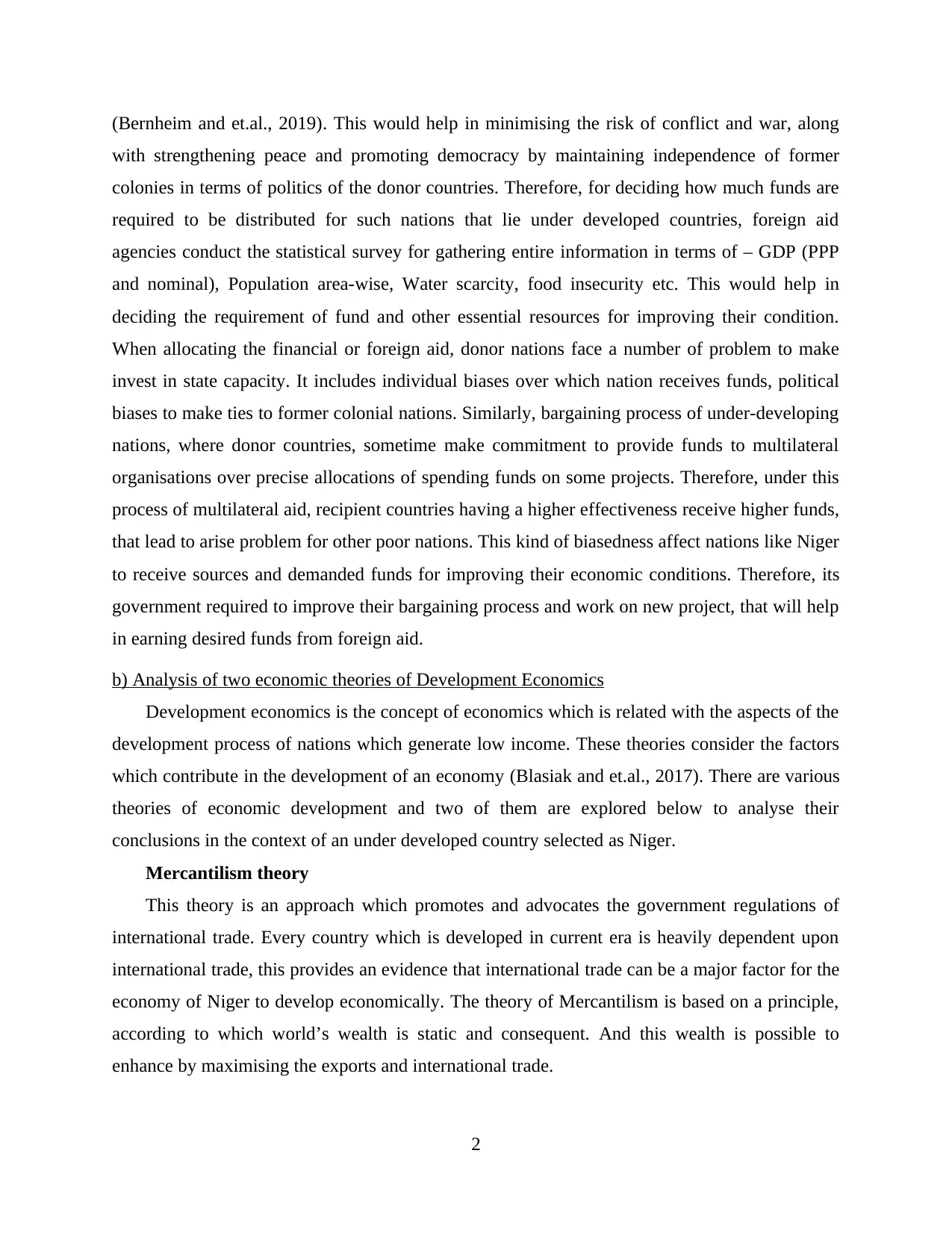
(Bernheim and et.al., 2019). This would help in minimising the risk of conflict and war, along
with strengthening peace and promoting democracy by maintaining independence of former
colonies in terms of politics of the donor countries. Therefore, for deciding how much funds are
required to be distributed for such nations that lie under developed countries, foreign aid
agencies conduct the statistical survey for gathering entire information in terms of – GDP (PPP
and nominal), Population area-wise, Water scarcity, food insecurity etc. This would help in
deciding the requirement of fund and other essential resources for improving their condition.
When allocating the financial or foreign aid, donor nations face a number of problem to make
invest in state capacity. It includes individual biases over which nation receives funds, political
biases to make ties to former colonial nations. Similarly, bargaining process of under-developing
nations, where donor countries, sometime make commitment to provide funds to multilateral
organisations over precise allocations of spending funds on some projects. Therefore, under this
process of multilateral aid, recipient countries having a higher effectiveness receive higher funds,
that lead to arise problem for other poor nations. This kind of biasedness affect nations like Niger
to receive sources and demanded funds for improving their economic conditions. Therefore, its
government required to improve their bargaining process and work on new project, that will help
in earning desired funds from foreign aid.
b) Analysis of two economic theories of Development Economics
Development economics is the concept of economics which is related with the aspects of the
development process of nations which generate low income. These theories consider the factors
which contribute in the development of an economy (Blasiak and et.al., 2017). There are various
theories of economic development and two of them are explored below to analyse their
conclusions in the context of an under developed country selected as Niger.
Mercantilism theory
This theory is an approach which promotes and advocates the government regulations of
international trade. Every country which is developed in current era is heavily dependent upon
international trade, this provides an evidence that international trade can be a major factor for the
economy of Niger to develop economically. The theory of Mercantilism is based on a principle,
according to which world’s wealth is static and consequent. And this wealth is possible to
enhance by maximising the exports and international trade.
2
with strengthening peace and promoting democracy by maintaining independence of former
colonies in terms of politics of the donor countries. Therefore, for deciding how much funds are
required to be distributed for such nations that lie under developed countries, foreign aid
agencies conduct the statistical survey for gathering entire information in terms of – GDP (PPP
and nominal), Population area-wise, Water scarcity, food insecurity etc. This would help in
deciding the requirement of fund and other essential resources for improving their condition.
When allocating the financial or foreign aid, donor nations face a number of problem to make
invest in state capacity. It includes individual biases over which nation receives funds, political
biases to make ties to former colonial nations. Similarly, bargaining process of under-developing
nations, where donor countries, sometime make commitment to provide funds to multilateral
organisations over precise allocations of spending funds on some projects. Therefore, under this
process of multilateral aid, recipient countries having a higher effectiveness receive higher funds,
that lead to arise problem for other poor nations. This kind of biasedness affect nations like Niger
to receive sources and demanded funds for improving their economic conditions. Therefore, its
government required to improve their bargaining process and work on new project, that will help
in earning desired funds from foreign aid.
b) Analysis of two economic theories of Development Economics
Development economics is the concept of economics which is related with the aspects of the
development process of nations which generate low income. These theories consider the factors
which contribute in the development of an economy (Blasiak and et.al., 2017). There are various
theories of economic development and two of them are explored below to analyse their
conclusions in the context of an under developed country selected as Niger.
Mercantilism theory
This theory is an approach which promotes and advocates the government regulations of
international trade. Every country which is developed in current era is heavily dependent upon
international trade, this provides an evidence that international trade can be a major factor for the
economy of Niger to develop economically. The theory of Mercantilism is based on a principle,
according to which world’s wealth is static and consequent. And this wealth is possible to
enhance by maximising the exports and international trade.
2
Paraphrase This Document
Need a fresh take? Get an instant paraphrase of this document with our AI Paraphraser
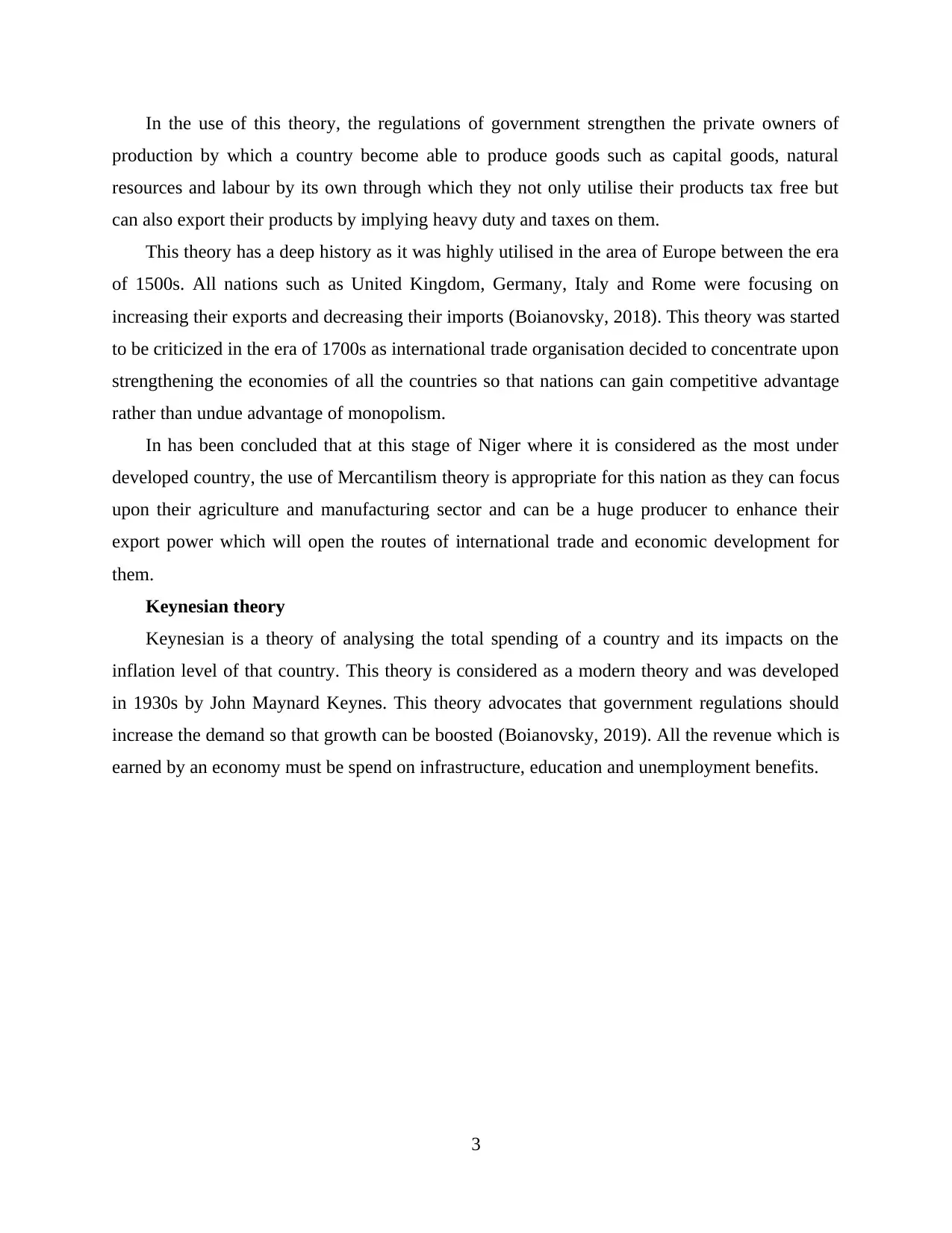
In the use of this theory, the regulations of government strengthen the private owners of
production by which a country become able to produce goods such as capital goods, natural
resources and labour by its own through which they not only utilise their products tax free but
can also export their products by implying heavy duty and taxes on them.
This theory has a deep history as it was highly utilised in the area of Europe between the era
of 1500s. All nations such as United Kingdom, Germany, Italy and Rome were focusing on
increasing their exports and decreasing their imports (Boianovsky, 2018). This theory was started
to be criticized in the era of 1700s as international trade organisation decided to concentrate upon
strengthening the economies of all the countries so that nations can gain competitive advantage
rather than undue advantage of monopolism.
In has been concluded that at this stage of Niger where it is considered as the most under
developed country, the use of Mercantilism theory is appropriate for this nation as they can focus
upon their agriculture and manufacturing sector and can be a huge producer to enhance their
export power which will open the routes of international trade and economic development for
them.
Keynesian theory
Keynesian is a theory of analysing the total spending of a country and its impacts on the
inflation level of that country. This theory is considered as a modern theory and was developed
in 1930s by John Maynard Keynes. This theory advocates that government regulations should
increase the demand so that growth can be boosted (Boianovsky, 2019). All the revenue which is
earned by an economy must be spend on infrastructure, education and unemployment benefits.
3
production by which a country become able to produce goods such as capital goods, natural
resources and labour by its own through which they not only utilise their products tax free but
can also export their products by implying heavy duty and taxes on them.
This theory has a deep history as it was highly utilised in the area of Europe between the era
of 1500s. All nations such as United Kingdom, Germany, Italy and Rome were focusing on
increasing their exports and decreasing their imports (Boianovsky, 2018). This theory was started
to be criticized in the era of 1700s as international trade organisation decided to concentrate upon
strengthening the economies of all the countries so that nations can gain competitive advantage
rather than undue advantage of monopolism.
In has been concluded that at this stage of Niger where it is considered as the most under
developed country, the use of Mercantilism theory is appropriate for this nation as they can focus
upon their agriculture and manufacturing sector and can be a huge producer to enhance their
export power which will open the routes of international trade and economic development for
them.
Keynesian theory
Keynesian is a theory of analysing the total spending of a country and its impacts on the
inflation level of that country. This theory is considered as a modern theory and was developed
in 1930s by John Maynard Keynes. This theory advocates that government regulations should
increase the demand so that growth can be boosted (Boianovsky, 2019). All the revenue which is
earned by an economy must be spend on infrastructure, education and unemployment benefits.
3
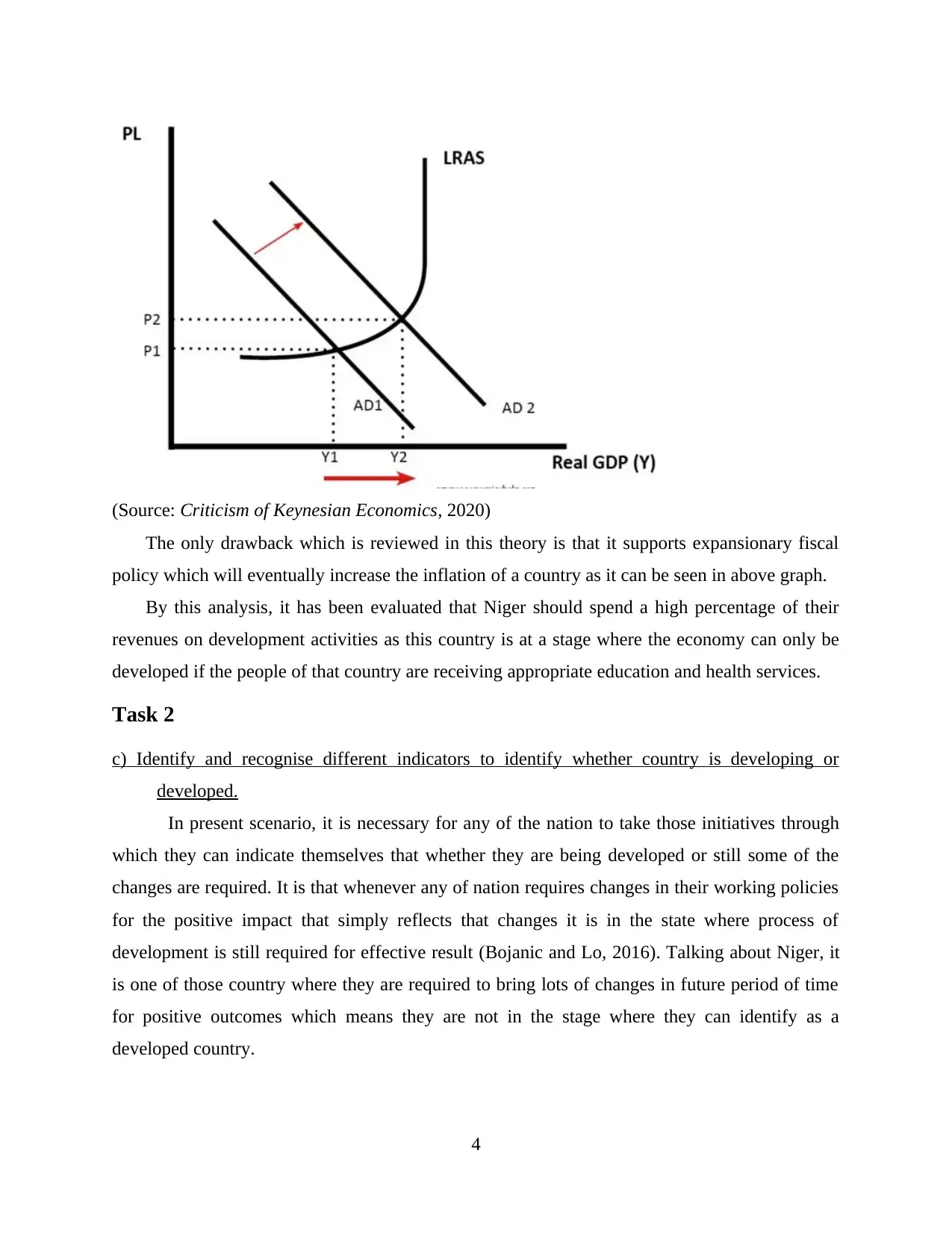
(Source: Criticism of Keynesian Economics, 2020)
The only drawback which is reviewed in this theory is that it supports expansionary fiscal
policy which will eventually increase the inflation of a country as it can be seen in above graph.
By this analysis, it has been evaluated that Niger should spend a high percentage of their
revenues on development activities as this country is at a stage where the economy can only be
developed if the people of that country are receiving appropriate education and health services.
Task 2
c) Identify and recognise different indicators to identify whether country is developing or
developed.
In present scenario, it is necessary for any of the nation to take those initiatives through
which they can indicate themselves that whether they are being developed or still some of the
changes are required. It is that whenever any of nation requires changes in their working policies
for the positive impact that simply reflects that changes it is in the state where process of
development is still required for effective result (Bojanic and Lo, 2016). Talking about Niger, it
is one of those country where they are required to bring lots of changes in future period of time
for positive outcomes which means they are not in the stage where they can identify as a
developed country.
4
The only drawback which is reviewed in this theory is that it supports expansionary fiscal
policy which will eventually increase the inflation of a country as it can be seen in above graph.
By this analysis, it has been evaluated that Niger should spend a high percentage of their
revenues on development activities as this country is at a stage where the economy can only be
developed if the people of that country are receiving appropriate education and health services.
Task 2
c) Identify and recognise different indicators to identify whether country is developing or
developed.
In present scenario, it is necessary for any of the nation to take those initiatives through
which they can indicate themselves that whether they are being developed or still some of the
changes are required. It is that whenever any of nation requires changes in their working policies
for the positive impact that simply reflects that changes it is in the state where process of
development is still required for effective result (Bojanic and Lo, 2016). Talking about Niger, it
is one of those country where they are required to bring lots of changes in future period of time
for positive outcomes which means they are not in the stage where they can identify as a
developed country.
4
⊘ This is a preview!⊘
Do you want full access?
Subscribe today to unlock all pages.

Trusted by 1+ million students worldwide
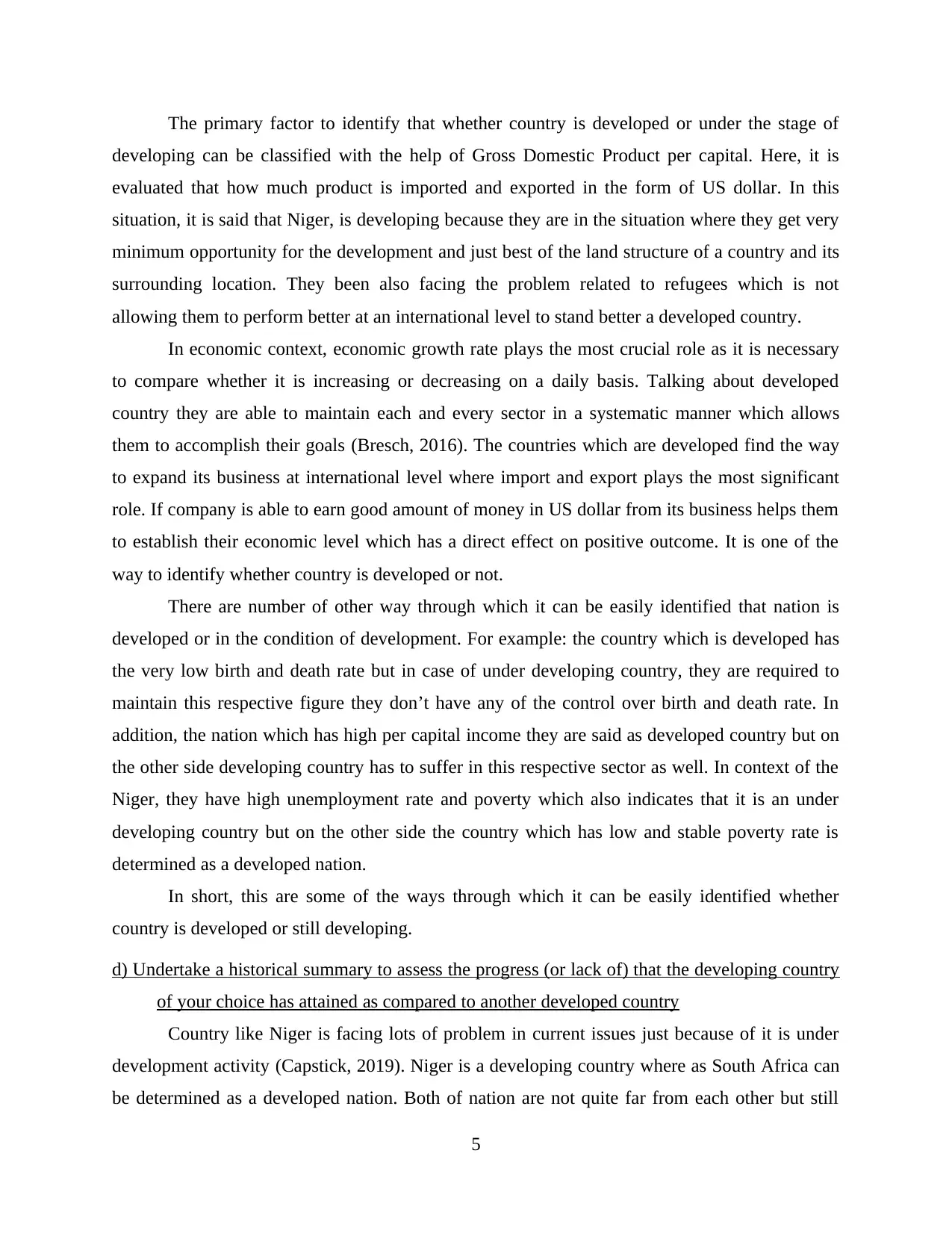
The primary factor to identify that whether country is developed or under the stage of
developing can be classified with the help of Gross Domestic Product per capital. Here, it is
evaluated that how much product is imported and exported in the form of US dollar. In this
situation, it is said that Niger, is developing because they are in the situation where they get very
minimum opportunity for the development and just best of the land structure of a country and its
surrounding location. They been also facing the problem related to refugees which is not
allowing them to perform better at an international level to stand better a developed country.
In economic context, economic growth rate plays the most crucial role as it is necessary
to compare whether it is increasing or decreasing on a daily basis. Talking about developed
country they are able to maintain each and every sector in a systematic manner which allows
them to accomplish their goals (Bresch, 2016). The countries which are developed find the way
to expand its business at international level where import and export plays the most significant
role. If company is able to earn good amount of money in US dollar from its business helps them
to establish their economic level which has a direct effect on positive outcome. It is one of the
way to identify whether country is developed or not.
There are number of other way through which it can be easily identified that nation is
developed or in the condition of development. For example: the country which is developed has
the very low birth and death rate but in case of under developing country, they are required to
maintain this respective figure they don’t have any of the control over birth and death rate. In
addition, the nation which has high per capital income they are said as developed country but on
the other side developing country has to suffer in this respective sector as well. In context of the
Niger, they have high unemployment rate and poverty which also indicates that it is an under
developing country but on the other side the country which has low and stable poverty rate is
determined as a developed nation.
In short, this are some of the ways through which it can be easily identified whether
country is developed or still developing.
d) Undertake a historical summary to assess the progress (or lack of) that the developing country
of your choice has attained as compared to another developed country
Country like Niger is facing lots of problem in current issues just because of it is under
development activity (Capstick, 2019). Niger is a developing country where as South Africa can
be determined as a developed nation. Both of nation are not quite far from each other but still
5
developing can be classified with the help of Gross Domestic Product per capital. Here, it is
evaluated that how much product is imported and exported in the form of US dollar. In this
situation, it is said that Niger, is developing because they are in the situation where they get very
minimum opportunity for the development and just best of the land structure of a country and its
surrounding location. They been also facing the problem related to refugees which is not
allowing them to perform better at an international level to stand better a developed country.
In economic context, economic growth rate plays the most crucial role as it is necessary
to compare whether it is increasing or decreasing on a daily basis. Talking about developed
country they are able to maintain each and every sector in a systematic manner which allows
them to accomplish their goals (Bresch, 2016). The countries which are developed find the way
to expand its business at international level where import and export plays the most significant
role. If company is able to earn good amount of money in US dollar from its business helps them
to establish their economic level which has a direct effect on positive outcome. It is one of the
way to identify whether country is developed or not.
There are number of other way through which it can be easily identified that nation is
developed or in the condition of development. For example: the country which is developed has
the very low birth and death rate but in case of under developing country, they are required to
maintain this respective figure they don’t have any of the control over birth and death rate. In
addition, the nation which has high per capital income they are said as developed country but on
the other side developing country has to suffer in this respective sector as well. In context of the
Niger, they have high unemployment rate and poverty which also indicates that it is an under
developing country but on the other side the country which has low and stable poverty rate is
determined as a developed nation.
In short, this are some of the ways through which it can be easily identified whether
country is developed or still developing.
d) Undertake a historical summary to assess the progress (or lack of) that the developing country
of your choice has attained as compared to another developed country
Country like Niger is facing lots of problem in current issues just because of it is under
development activity (Capstick, 2019). Niger is a developing country where as South Africa can
be determined as a developed nation. Both of nation are not quite far from each other but still
5
Paraphrase This Document
Need a fresh take? Get an instant paraphrase of this document with our AI Paraphraser

they have lots of differences. Talking about annual GDP of Niger in 2018, it was just $9.299M
but on the other side South Africa had a GDP of $368,135M which is totally opposite of each
other. There is the situation where Niger has to suffer for delivering the human rights to its
public just because of its current position but on the other side people of South Africa gets the
chances to deliver better facilities to its public. It is the sign that developed country gets the
option to supports its people but on the other side poor nation faces lots of difficulties in number
of circumstances. Also, developed country like South Africa gets the opportunity to enhance
their business but in case of Niger lots of problem is needed to be face by them.
(Source: Country comparison Niger vs South Africa, 2020)
As compared the GDP of Niger with South Africa, it has been illustrated from this figure
that there is less growth rate in Niger. From 1951 to till 2017, it has been estimated that increased
$1.128M from $3.0M only, while South Africa which was considered as developed one,
$1.150.8 M to $88.837M. Therefore, donor countries are required to provide sources for Niger
government that helps in improving its GDP rate, so that people can earn a proper livelihood.
TASK 3
(e) Outcome of international summits in which Niger country participated in recent years and
assess the remaining gaps in the implementation of the outcomes of these summits
International Summits is the kind of meeting among various countries where people of
different countries decide one venue and where they conduct meeting. Conference will helps in
specific country and world's leaders participated and discussed about various aspects such as
social, financial, political, economic and community or cooperation (Casadella and Uzunidis,
6
but on the other side South Africa had a GDP of $368,135M which is totally opposite of each
other. There is the situation where Niger has to suffer for delivering the human rights to its
public just because of its current position but on the other side people of South Africa gets the
chances to deliver better facilities to its public. It is the sign that developed country gets the
option to supports its people but on the other side poor nation faces lots of difficulties in number
of circumstances. Also, developed country like South Africa gets the opportunity to enhance
their business but in case of Niger lots of problem is needed to be face by them.
(Source: Country comparison Niger vs South Africa, 2020)
As compared the GDP of Niger with South Africa, it has been illustrated from this figure
that there is less growth rate in Niger. From 1951 to till 2017, it has been estimated that increased
$1.128M from $3.0M only, while South Africa which was considered as developed one,
$1.150.8 M to $88.837M. Therefore, donor countries are required to provide sources for Niger
government that helps in improving its GDP rate, so that people can earn a proper livelihood.
TASK 3
(e) Outcome of international summits in which Niger country participated in recent years and
assess the remaining gaps in the implementation of the outcomes of these summits
International Summits is the kind of meeting among various countries where people of
different countries decide one venue and where they conduct meeting. Conference will helps in
specific country and world's leaders participated and discussed about various aspects such as
social, financial, political, economic and community or cooperation (Casadella and Uzunidis,
6

2017). There are one of international submits which helps between the India or Niger and that
international conferences has purpose and it will provide effective outcomes which positively
impact both countries.
Niger country situated in sub- Sahara region of West Africa. Between India and Niger,
Bilateral relations are very friendly or warm that is beneficial for both in every aspect. Republic
of Niger had open their Embassy in November 2011 in the location of New Delhi. There several
visits done by Niger for different purpose. In 2015, Issoufou Mahamadou president of Niger was
visited India to participate in the India -Africa Forum Summit. After that, in 2018 March
Founding Conference of International Solar Alliance organized. At the time of visiting both
conferences, president of Niger met with Indian Prime Minister Modi.
On 19th March 2018, international submits had organized between Niger and India in
New Delhi and co chaired by Indian Prime Minister and French president Emmanuel Macron.
Solar alliance was jointly declared and signed with multiple international organizations, along
with international energy agency, International renewable energy agency and united nations
industrial development organizations.
The ISA ( International Solar Alliance ) is an agreement which is based on international
inter-governmental organization. Its main purpose is to offer that platform which helps in
promoting solar energy across the world before 2030 (Cherif and Dreger, 2016). In addition, this
conference held to gather around US $1 trillion of investment in order to produce solar energy at
inexpensive costs. One aspect focus on International Solar Alliance and try to reduce its overall
cost in order to make cost effective for individuals. But, it has various risk related to investment
which become significant barrier or further influence the growth of solar.
Joint declaration between International Solar Alliance and International Energy Agency,
both are agreed to share capacity building programs and on the basis of it they create extremity
joint policy. In order to facilitate International Energy Agency they work together with
Technology Collaboration Programmes. IRENA committed to collaborate with ISA to help other
countries to develop policies and various regulations to produce solar energy. In addition, there
are various initiatives taken by the IRENA such as Clean Energy Corridors and SIDS
Lighthouses. ISA and UNIDO, both are agreed to spread awareness regarding benefits of solar
energy and also recommend other countries to modify their nations policies and practices
accordingly to maximise the deployment of solar energy.
7
international conferences has purpose and it will provide effective outcomes which positively
impact both countries.
Niger country situated in sub- Sahara region of West Africa. Between India and Niger,
Bilateral relations are very friendly or warm that is beneficial for both in every aspect. Republic
of Niger had open their Embassy in November 2011 in the location of New Delhi. There several
visits done by Niger for different purpose. In 2015, Issoufou Mahamadou president of Niger was
visited India to participate in the India -Africa Forum Summit. After that, in 2018 March
Founding Conference of International Solar Alliance organized. At the time of visiting both
conferences, president of Niger met with Indian Prime Minister Modi.
On 19th March 2018, international submits had organized between Niger and India in
New Delhi and co chaired by Indian Prime Minister and French president Emmanuel Macron.
Solar alliance was jointly declared and signed with multiple international organizations, along
with international energy agency, International renewable energy agency and united nations
industrial development organizations.
The ISA ( International Solar Alliance ) is an agreement which is based on international
inter-governmental organization. Its main purpose is to offer that platform which helps in
promoting solar energy across the world before 2030 (Cherif and Dreger, 2016). In addition, this
conference held to gather around US $1 trillion of investment in order to produce solar energy at
inexpensive costs. One aspect focus on International Solar Alliance and try to reduce its overall
cost in order to make cost effective for individuals. But, it has various risk related to investment
which become significant barrier or further influence the growth of solar.
Joint declaration between International Solar Alliance and International Energy Agency,
both are agreed to share capacity building programs and on the basis of it they create extremity
joint policy. In order to facilitate International Energy Agency they work together with
Technology Collaboration Programmes. IRENA committed to collaborate with ISA to help other
countries to develop policies and various regulations to produce solar energy. In addition, there
are various initiatives taken by the IRENA such as Clean Energy Corridors and SIDS
Lighthouses. ISA and UNIDO, both are agreed to spread awareness regarding benefits of solar
energy and also recommend other countries to modify their nations policies and practices
accordingly to maximise the deployment of solar energy.
7
⊘ This is a preview!⊘
Do you want full access?
Subscribe today to unlock all pages.

Trusted by 1+ million students worldwide
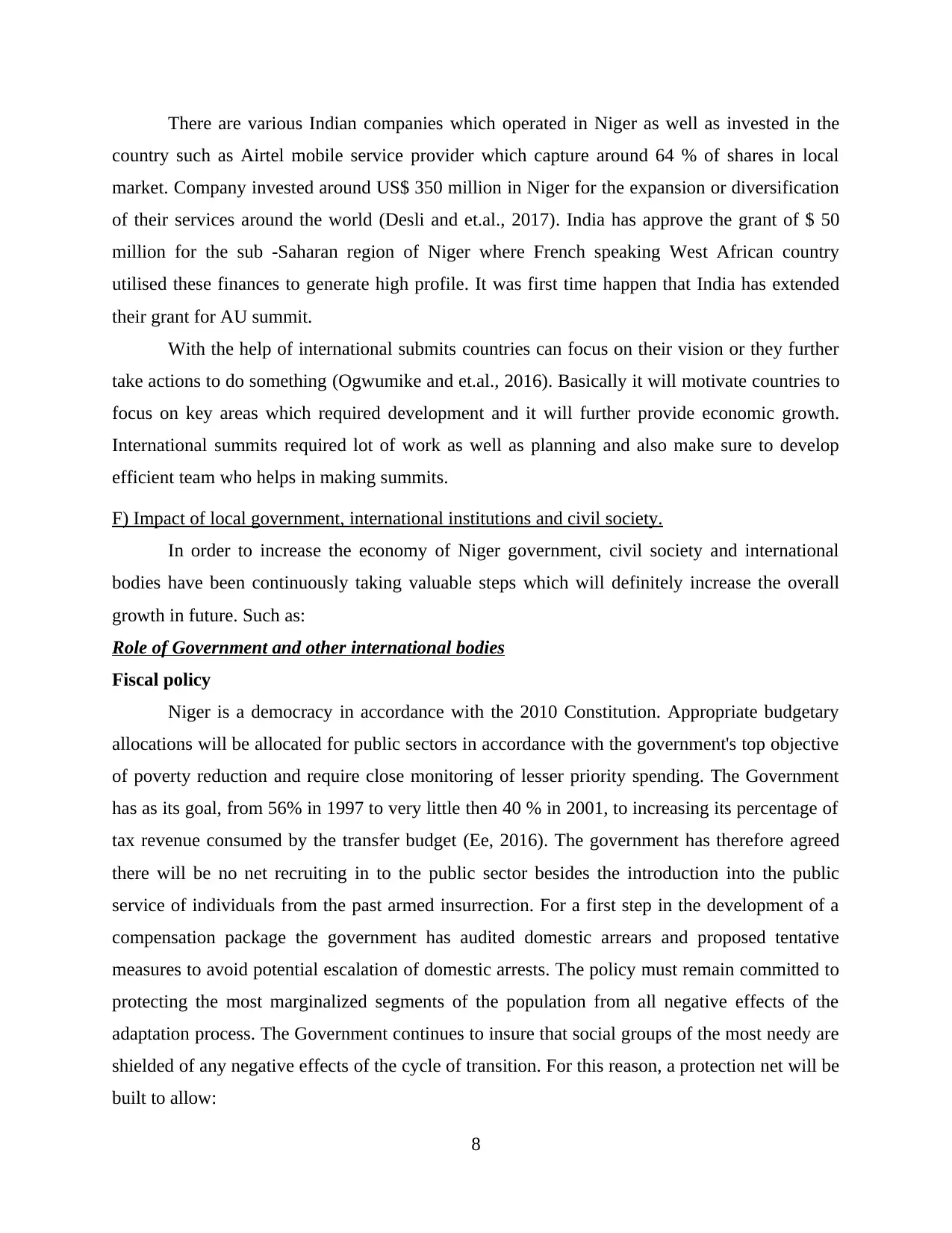
There are various Indian companies which operated in Niger as well as invested in the
country such as Airtel mobile service provider which capture around 64 % of shares in local
market. Company invested around US$ 350 million in Niger for the expansion or diversification
of their services around the world (Desli and et.al., 2017). India has approve the grant of $ 50
million for the sub -Saharan region of Niger where French speaking West African country
utilised these finances to generate high profile. It was first time happen that India has extended
their grant for AU summit.
With the help of international submits countries can focus on their vision or they further
take actions to do something (Ogwumike and et.al., 2016). Basically it will motivate countries to
focus on key areas which required development and it will further provide economic growth.
International summits required lot of work as well as planning and also make sure to develop
efficient team who helps in making summits.
F) Impact of local government, international institutions and civil society.
In order to increase the economy of Niger government, civil society and international
bodies have been continuously taking valuable steps which will definitely increase the overall
growth in future. Such as:
Role of Government and other international bodies
Fiscal policy
Niger is a democracy in accordance with the 2010 Constitution. Appropriate budgetary
allocations will be allocated for public sectors in accordance with the government's top objective
of poverty reduction and require close monitoring of lesser priority spending. The Government
has as its goal, from 56% in 1997 to very little then 40 % in 2001, to increasing its percentage of
tax revenue consumed by the transfer budget (Ee, 2016). The government has therefore agreed
there will be no net recruiting in to the public sector besides the introduction into the public
service of individuals from the past armed insurrection. For a first step in the development of a
compensation package the government has audited domestic arrears and proposed tentative
measures to avoid potential escalation of domestic arrests. The policy must remain committed to
protecting the most marginalized segments of the population from all negative effects of the
adaptation process. The Government continues to insure that social groups of the most needy are
shielded of any negative effects of the cycle of transition. For this reason, a protection net will be
built to allow:
8
country such as Airtel mobile service provider which capture around 64 % of shares in local
market. Company invested around US$ 350 million in Niger for the expansion or diversification
of their services around the world (Desli and et.al., 2017). India has approve the grant of $ 50
million for the sub -Saharan region of Niger where French speaking West African country
utilised these finances to generate high profile. It was first time happen that India has extended
their grant for AU summit.
With the help of international submits countries can focus on their vision or they further
take actions to do something (Ogwumike and et.al., 2016). Basically it will motivate countries to
focus on key areas which required development and it will further provide economic growth.
International summits required lot of work as well as planning and also make sure to develop
efficient team who helps in making summits.
F) Impact of local government, international institutions and civil society.
In order to increase the economy of Niger government, civil society and international
bodies have been continuously taking valuable steps which will definitely increase the overall
growth in future. Such as:
Role of Government and other international bodies
Fiscal policy
Niger is a democracy in accordance with the 2010 Constitution. Appropriate budgetary
allocations will be allocated for public sectors in accordance with the government's top objective
of poverty reduction and require close monitoring of lesser priority spending. The Government
has as its goal, from 56% in 1997 to very little then 40 % in 2001, to increasing its percentage of
tax revenue consumed by the transfer budget (Ee, 2016). The government has therefore agreed
there will be no net recruiting in to the public sector besides the introduction into the public
service of individuals from the past armed insurrection. For a first step in the development of a
compensation package the government has audited domestic arrears and proposed tentative
measures to avoid potential escalation of domestic arrests. The policy must remain committed to
protecting the most marginalized segments of the population from all negative effects of the
adaptation process. The Government continues to insure that social groups of the most needy are
shielded of any negative effects of the cycle of transition. For this reason, a protection net will be
built to allow:
8
Paraphrase This Document
Need a fresh take? Get an instant paraphrase of this document with our AI Paraphraser
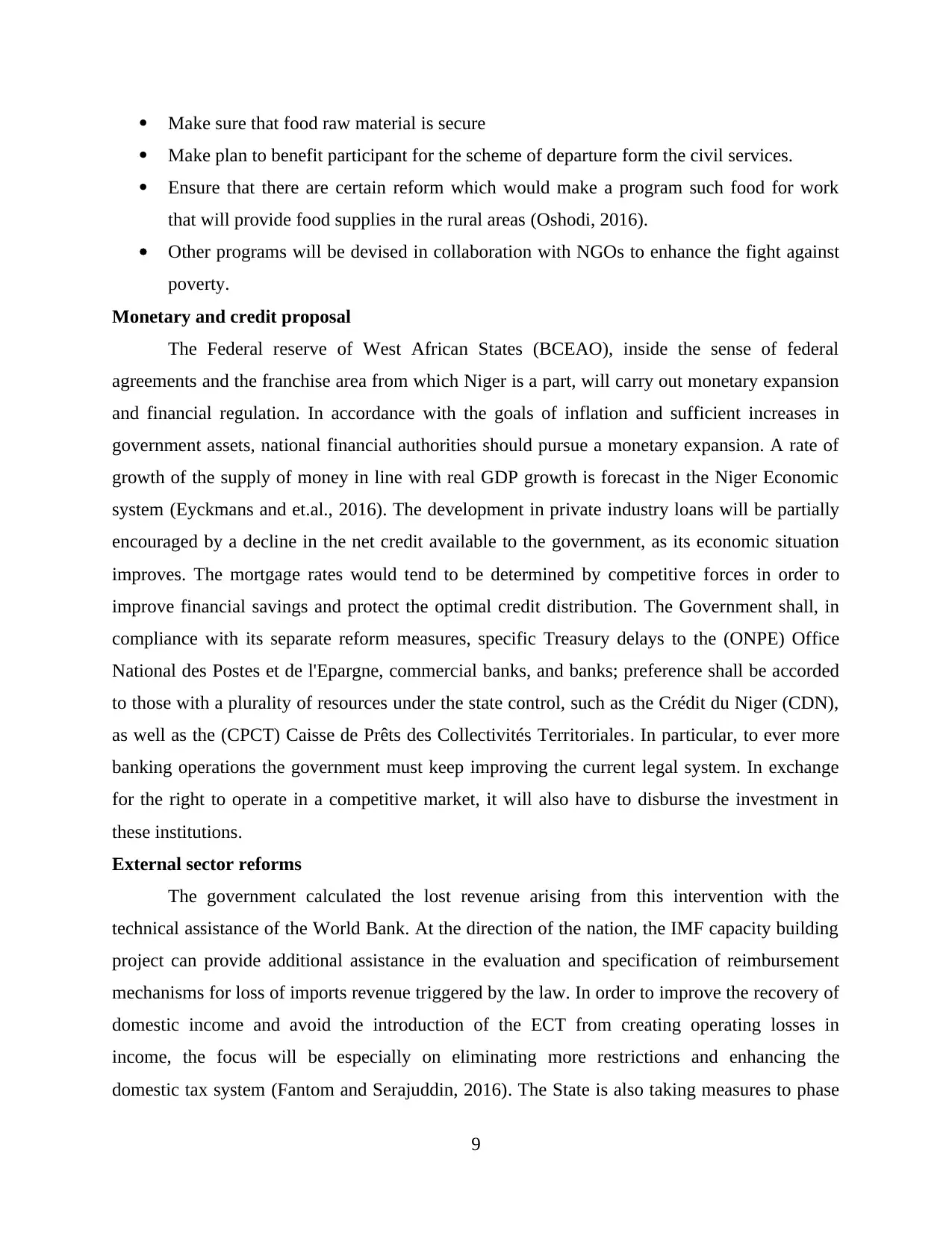
Make sure that food raw material is secure
Make plan to benefit participant for the scheme of departure form the civil services.
Ensure that there are certain reform which would make a program such food for work
that will provide food supplies in the rural areas (Oshodi, 2016).
Other programs will be devised in collaboration with NGOs to enhance the fight against
poverty.
Monetary and credit proposal
The Federal reserve of West African States (BCEAO), inside the sense of federal
agreements and the franchise area from which Niger is a part, will carry out monetary expansion
and financial regulation. In accordance with the goals of inflation and sufficient increases in
government assets, national financial authorities should pursue a monetary expansion. A rate of
growth of the supply of money in line with real GDP growth is forecast in the Niger Economic
system (Eyckmans and et.al., 2016). The development in private industry loans will be partially
encouraged by a decline in the net credit available to the government, as its economic situation
improves. The mortgage rates would tend to be determined by competitive forces in order to
improve financial savings and protect the optimal credit distribution. The Government shall, in
compliance with its separate reform measures, specific Treasury delays to the (ONPE) Office
National des Postes et de l'Epargne, commercial banks, and banks; preference shall be accorded
to those with a plurality of resources under the state control, such as the Crédit du Niger (CDN),
as well as the (CPCT) Caisse de Prêts des Collectivités Territoriales. In particular, to ever more
banking operations the government must keep improving the current legal system. In exchange
for the right to operate in a competitive market, it will also have to disburse the investment in
these institutions.
External sector reforms
The government calculated the lost revenue arising from this intervention with the
technical assistance of the World Bank. At the direction of the nation, the IMF capacity building
project can provide additional assistance in the evaluation and specification of reimbursement
mechanisms for loss of imports revenue triggered by the law. In order to improve the recovery of
domestic income and avoid the introduction of the ECT from creating operating losses in
income, the focus will be especially on eliminating more restrictions and enhancing the
domestic tax system (Fantom and Serajuddin, 2016). The State is also taking measures to phase
9
Make plan to benefit participant for the scheme of departure form the civil services.
Ensure that there are certain reform which would make a program such food for work
that will provide food supplies in the rural areas (Oshodi, 2016).
Other programs will be devised in collaboration with NGOs to enhance the fight against
poverty.
Monetary and credit proposal
The Federal reserve of West African States (BCEAO), inside the sense of federal
agreements and the franchise area from which Niger is a part, will carry out monetary expansion
and financial regulation. In accordance with the goals of inflation and sufficient increases in
government assets, national financial authorities should pursue a monetary expansion. A rate of
growth of the supply of money in line with real GDP growth is forecast in the Niger Economic
system (Eyckmans and et.al., 2016). The development in private industry loans will be partially
encouraged by a decline in the net credit available to the government, as its economic situation
improves. The mortgage rates would tend to be determined by competitive forces in order to
improve financial savings and protect the optimal credit distribution. The Government shall, in
compliance with its separate reform measures, specific Treasury delays to the (ONPE) Office
National des Postes et de l'Epargne, commercial banks, and banks; preference shall be accorded
to those with a plurality of resources under the state control, such as the Crédit du Niger (CDN),
as well as the (CPCT) Caisse de Prêts des Collectivités Territoriales. In particular, to ever more
banking operations the government must keep improving the current legal system. In exchange
for the right to operate in a competitive market, it will also have to disburse the investment in
these institutions.
External sector reforms
The government calculated the lost revenue arising from this intervention with the
technical assistance of the World Bank. At the direction of the nation, the IMF capacity building
project can provide additional assistance in the evaluation and specification of reimbursement
mechanisms for loss of imports revenue triggered by the law. In order to improve the recovery of
domestic income and avoid the introduction of the ECT from creating operating losses in
income, the focus will be especially on eliminating more restrictions and enhancing the
domestic tax system (Fantom and Serajuddin, 2016). The State is also taking measures to phase
9
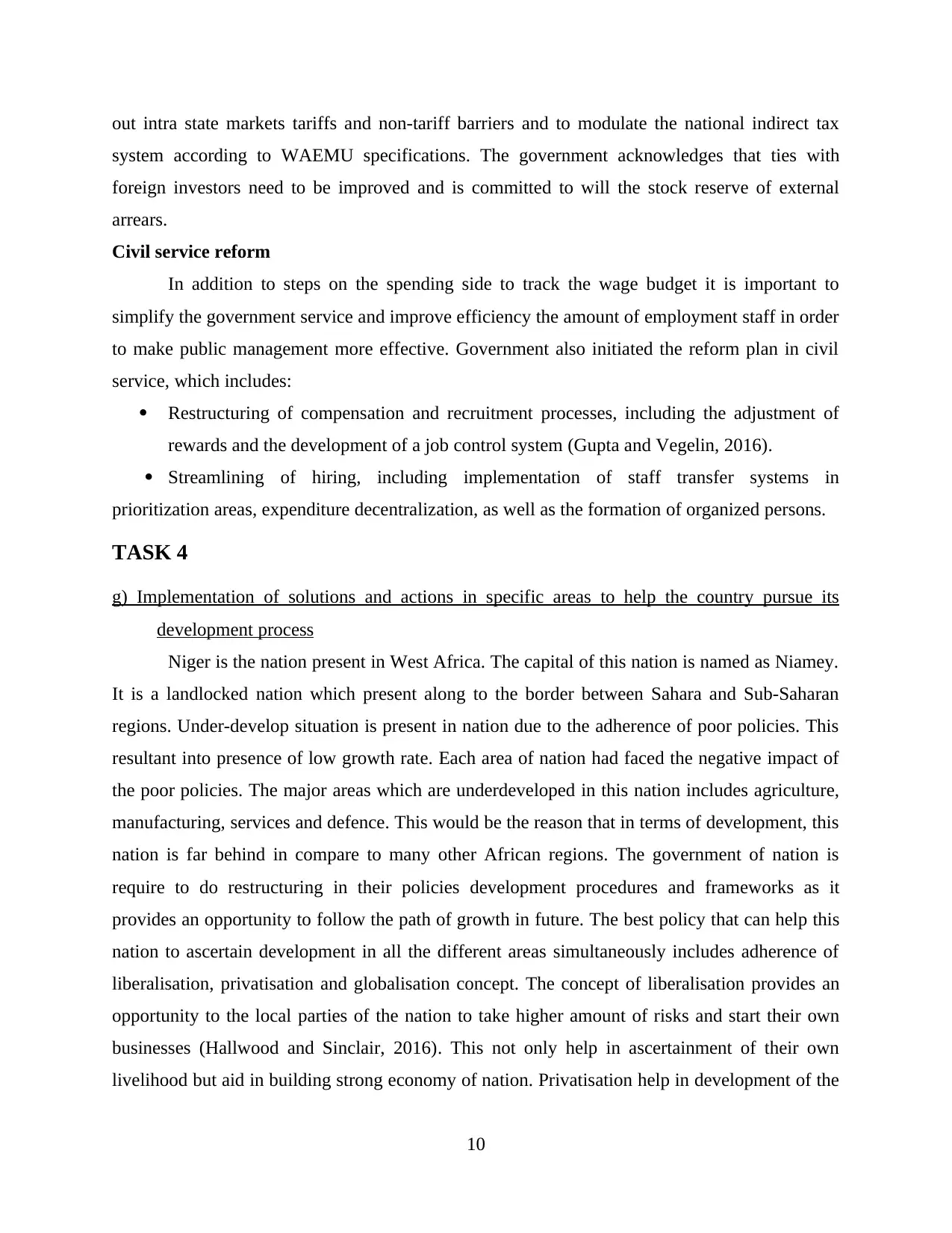
out intra state markets tariffs and non-tariff barriers and to modulate the national indirect tax
system according to WAEMU specifications. The government acknowledges that ties with
foreign investors need to be improved and is committed to will the stock reserve of external
arrears.
Civil service reform
In addition to steps on the spending side to track the wage budget it is important to
simplify the government service and improve efficiency the amount of employment staff in order
to make public management more effective. Government also initiated the reform plan in civil
service, which includes:
Restructuring of compensation and recruitment processes, including the adjustment of
rewards and the development of a job control system (Gupta and Vegelin, 2016).
Streamlining of hiring, including implementation of staff transfer systems in
prioritization areas, expenditure decentralization, as well as the formation of organized persons.
TASK 4
g) Implementation of solutions and actions in specific areas to help the country pursue its
development process
Niger is the nation present in West Africa. The capital of this nation is named as Niamey.
It is a landlocked nation which present along to the border between Sahara and Sub-Saharan
regions. Under-develop situation is present in nation due to the adherence of poor policies. This
resultant into presence of low growth rate. Each area of nation had faced the negative impact of
the poor policies. The major areas which are underdeveloped in this nation includes agriculture,
manufacturing, services and defence. This would be the reason that in terms of development, this
nation is far behind in compare to many other African regions. The government of nation is
require to do restructuring in their policies development procedures and frameworks as it
provides an opportunity to follow the path of growth in future. The best policy that can help this
nation to ascertain development in all the different areas simultaneously includes adherence of
liberalisation, privatisation and globalisation concept. The concept of liberalisation provides an
opportunity to the local parties of the nation to take higher amount of risks and start their own
businesses (Hallwood and Sinclair, 2016). This not only help in ascertainment of their own
livelihood but aid in building strong economy of nation. Privatisation help in development of the
10
system according to WAEMU specifications. The government acknowledges that ties with
foreign investors need to be improved and is committed to will the stock reserve of external
arrears.
Civil service reform
In addition to steps on the spending side to track the wage budget it is important to
simplify the government service and improve efficiency the amount of employment staff in order
to make public management more effective. Government also initiated the reform plan in civil
service, which includes:
Restructuring of compensation and recruitment processes, including the adjustment of
rewards and the development of a job control system (Gupta and Vegelin, 2016).
Streamlining of hiring, including implementation of staff transfer systems in
prioritization areas, expenditure decentralization, as well as the formation of organized persons.
TASK 4
g) Implementation of solutions and actions in specific areas to help the country pursue its
development process
Niger is the nation present in West Africa. The capital of this nation is named as Niamey.
It is a landlocked nation which present along to the border between Sahara and Sub-Saharan
regions. Under-develop situation is present in nation due to the adherence of poor policies. This
resultant into presence of low growth rate. Each area of nation had faced the negative impact of
the poor policies. The major areas which are underdeveloped in this nation includes agriculture,
manufacturing, services and defence. This would be the reason that in terms of development, this
nation is far behind in compare to many other African regions. The government of nation is
require to do restructuring in their policies development procedures and frameworks as it
provides an opportunity to follow the path of growth in future. The best policy that can help this
nation to ascertain development in all the different areas simultaneously includes adherence of
liberalisation, privatisation and globalisation concept. The concept of liberalisation provides an
opportunity to the local parties of the nation to take higher amount of risks and start their own
businesses (Hallwood and Sinclair, 2016). This not only help in ascertainment of their own
livelihood but aid in building strong economy of nation. Privatisation help in development of the
10
⊘ This is a preview!⊘
Do you want full access?
Subscribe today to unlock all pages.

Trusted by 1+ million students worldwide
1 out of 18
Related Documents
Your All-in-One AI-Powered Toolkit for Academic Success.
+13062052269
info@desklib.com
Available 24*7 on WhatsApp / Email
![[object Object]](/_next/static/media/star-bottom.7253800d.svg)
Unlock your academic potential
Copyright © 2020–2026 A2Z Services. All Rights Reserved. Developed and managed by ZUCOL.





